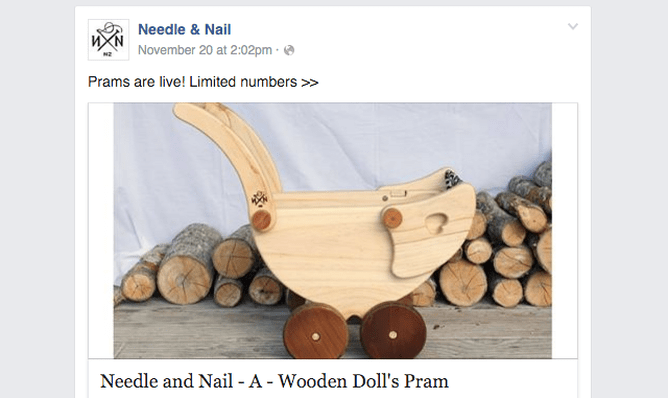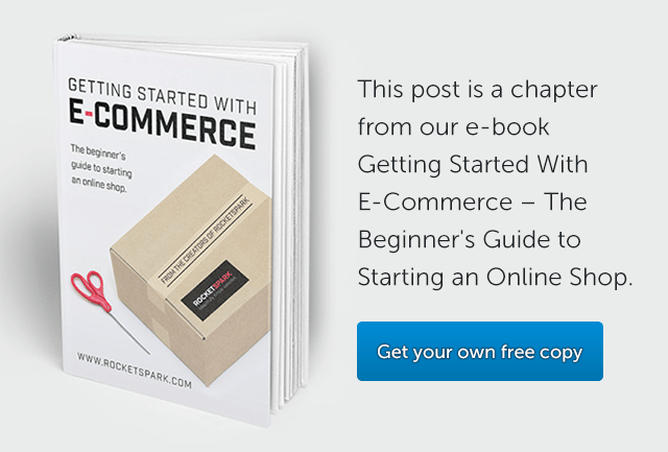This post is a chapter from our e-book Getting Started With E-Commerce – The Beginner's Guide to Starting an Online Shop.
Download your own free copy to learn how to start an online shop
Why build a social media following?
For some businesses the benefits of being active on social media is pretty small – but retail is one of the industries where social media carries massive potential for major results. Among our own clients we see quite a high correlation between good quality social media activity and success with online sales.
Retail businesses usually build a following much faster than traditional service businesses. This is partly related to the fact that their products are so visual. When retail businesses post photos of new products up on Facebook that their followers want, they’re more likely to express this with a comment, a like or a share, and thus interact with your post. With social media, interactions multiply the effectiveness of every post. Why? Because when one of your followers comments, all of their followers are potentially exposed to your products, leading to more followers—and more potential customers.
In the big bad world of Google searches, it can be a real challenge for small ecommerce businesses to get traffic to their site. But if you can grow a base of thousands of followers through social media and promote your products to them, you’re likely to generate sales.
One example is Needle and Nail, one of our clients here at Rocketspark. When we first began writing this e-book they had 2500 Facebook followers and as at November 2015, they had over 4000. When they add a new product to their range, they post about it on Facebook. The post generates interaction from their followers, which, in turn, leads to a spike in traffic to their website and this ultimately leads to more sales.
How to build a following
To understand building an effective following, we need to look at demand, price and selection. This is something we covered in Chapter One in this series. The more unique your product is and if you’re the only place that can source it, the more likely they are to follow you and interact with your posts. They’re also then more likely to buy from you.
Assuming you have a product people are interested in, building a following on social media is as simple as posting regularly. But don’t just post the same things all the time - mix it up. Needle and Nail, who we mentioned earlier, use social media to promote:
- New products
- One of a kind items
- Events like markets they’ll be selling at
- Other boutique stores that their followers might be interested in, and…
- New products coming soon, to help generate a buzz.
So long as your posts are interesting, then the more you can post, the better. The sweet spot is between once a week and a couple of times a day.
Which social networks?
For most retail businesses, Facebook is a must. It’s by far the largest social network and it’s the one where the retail audience is most active. While it’s good to be active on several social networks, for some small business owners, it’s just not feasible. Having enough time to post regularly on one social network is difficult enough, without throwing extra ones into the mix. So some businesses prefer to focus on just one network.
But the other social network that is particularly relevant to retail is Pinterest. Pinterest is essentially a giant, never-ending feed of images. If they see something they like, they “pin” it to their on electronic pinboard. There’s a couple of different ways of using Pinterest:
Firstly, you can post your own products. The Pinterest community is essentially voting on what’s most popular. If they like your product, you’ll get more exposure.
Or, secondly, you can post other people’s products that might be relevant to your followers. If, say, you’re running a design, fashion or homeware business, showing that you have an eye for what’s in vogue will translate to more people following you. And then they’ll see your products.
Send your social media followers to your website
Social media is great for building your audience but the most effective point-of-sale is on an ecommerce website. So the underlying goal of social media should still be to get your followers to visit your website. Be careful though: social media is not the place for a hard sell. If you try and sell too hard on social media, you’ll turn your followers off. Focus on promoting your brand and products, and traffic to your website will come as a result.
As the owner of an online shop, it’s likely that you’ve got quite a bit of expertise to share. Blogging is a great way to show your expertise and draw people to your website. And sharing a link to your blog articles allows you to keep your social media posts short and snappy with extra, more in-depth reading on your blog for those who want to learn more.
As we’ll see later, individual blog posts can be very powerful for search results. But using Facebook to share links to blog posts on your website is what will give you the initial boost of web traffic. Blogging is a way to get social media followers to your website in a non-salesy kind of way. If a visitor is reading a blog post on your website and likes what you have to say, then there’s a good chance that they’ll explore your website further, hopefully leading to a sale. A good is example of this is Rocketspark customer Mr Ralph, a lighting shop. They share their knowledge of designer lighting through their blog posts, which they then share through their Facebook page to generate traffic to their website.
Regularly remind your followers you exist
When life gets busy, it’s really easy to stop posting regularly and the benefits will dry up almost instantly. Social media is not a marketing tool where you can just “set it and forget it”.
We’ve learnt that the key to regularity is to set up a calendar scheduling your activity. When we here at Rocketspark have a plan for our social media and blog activity, that’s when it actually happens.
Want to learn more about social media for your business? Check out these articles:




